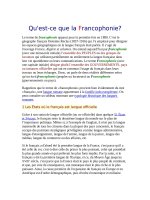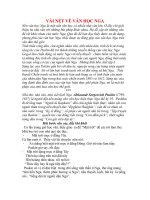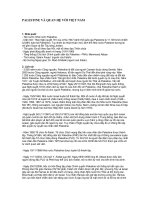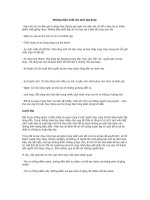vài nét về leukemia kinh dòng bạch cầu hatr
Bạn đang xem bản rút gọn của tài liệu. Xem và tải ngay bản đầy đủ của tài liệu tại đây (712.85 KB, 25 trang )
Vài nét về
leukemia kinh
dòng bạch cầu
Khái niệm
• Thuộc nhóm tăng sinh tuỷ mạn tính ác
tính
• Đặc trưng bởi tăng sinh bc hạt biệt hoá
Máu ngoại vi có đủ lứa tuổi của dòng bc
hạt
1.Giai đoạn mạn
Bc đoạn trung tính tăng cao,đủ các lứa
tuổi blast <2%(máu) và<5%(tuỷ)
Tăng bc ưa acid và bazơ ở máu
Thiếu máu nhẹ,dòng hc ở tuỷ thường giảm
về %
Tiểu cầu bình thường hoặc tăng.Hay gặp
mẫu tc nhỏ ,giảm múi nhân
Tăng sợi reticulin
Có thể gặp:tb Pseudo-gaucher,histiocyte
2.Giai đoạn tăng tốc
Blast chiếm 10-19% bc ở máu và/hoặc tb
có nhân trong tuỷ
Bc ưa bazơ ở máu ≥20%
Tc<100G/l hoặc>1000G/l kéo dài,ko do
điều trị
Lách to và tăng bc ko đáp ứng điều trị
Bằng chứng di truyền của sự tổn thương tế
bào
3.Giai đoạn chuyển cấp
Blast chiếm ≥20% ở máu ngoại vi hoặc tế
bào có nhân trong tuỷ
Tăng sinh blast ngoài tuỷ
Blast tập trung thành ổ lớn hoặc đám trên
tiêu bản sinh thiết tuỷ xương
Di truyền
• 90%-95% trường hợp có t(9;22)
(q34;q11)
→ NST Phl (NST 22 ngắn) với gen BCR-ABL
•ABL là nonreceptor tyrosine kinase,NST 9
• BCR nằm trên NST 22,có 3 vị trí cắt
M-BCR ở exons 12-16 →gen p210(tăng
tyrosin kinase hoạt hoá),hay gặp
µ-BCR ở exons 17-20 →gen p230(tăng
dòng bc hạt trưởng thành,tăng tiểu cầu)
m-BCR ở exons 1-2→gen p190 ( ALL,tăng
bc mono)
Điều trị
Một số phương pháp điều trị
• Ức chế tyrosine kinase :
imatinib,dasatinib,nilotinib
• Hydroxyurea (ức chế chọn lọc AND):1-6
g/ngày
• Interferon α (ức chế phân bào) 3000UI/ngày
• Gạn bạch cầu
• Ghép tuỷ
• Trong pha cấp :điều trị như leukemia cấp
Imatinib
Dẫn xuất 2 phenylaminopyrimidine
ức chế đặc hiệu với vị trí hoạt động của
tyrosine kinase ở: gen abl (the Abelson
proto-oncogene), c-kit and PDGF-R
(platelet-derived growth factor receptor)
Liều: 400mg/ngày,liều cao 800mg/ngày
Tiêu chuẩn lui bệnh
• Về tế bào:BC<10G/L,TC<450G/l,không có
tế bào chưa trưởng thành ở máu,hết gan
lách to trong ít nhất 4 tuần
• Về di tuyền:<35% tế bào có Phl (+)
• Về phân tử:
Lui bệnh một phần:BCR-ABL/ABL<0.05%
Lui bệnh hoàn toàn:BCR-ABL(-) bằng RTPCR
Theo dõi trong điều trị
imitanib
• FISH,RT-PCR (BCR-ABL) trong máu vào
tháng thứ 3,6,9,12
• Kiểm tra di truyền học tế bào ở tuỷ tháng
thứ 12
• Sau đó:duy trì FISH ,RT-PCR máu 4
tháng/lần, di truyền học tế bào ở tuỷ 1
năm /lần
Fluorescence in situ
hybridization
• only 20 to 25 cells in metaphase are examined per
sample. In the 10 percent of patients with CML in
whom the Ph chromosome cannot be demonstrated
by cytogenetic studies
• Genomic polymerase-chain-reaction (PCR) and
Southern blot analysis can determine the exact
breakpoints of DNA fusion products. Reversetranscriptase PCR (RT-PCR) and Northern blot
analysis allow detection of BCR–ABL transcripts at
the RNA level. The p210BCR–ABL protein can be
demonstrated by using antibodies against the Nterminal region of BCR and the C-terminal region of
ABL in immunoprecipitation or Western blot
analysis.48
• Fish allows analysis of both cells in
metaphase and nondividing cells in
interphase, and the results are easily
quantifiable. it has a false positive rate of up
to 10 percent and is not useful if fewer than
10 percent of cells contain a Ph chromosome
• Quantitative RT-PCR is used for follow-up of
patients after stem-cell transplantation,49
but its use in those receiving interferon alfa
therapy is more controversial
• Ph+ CML in Blast Crisis (BC), Accelerated Phase
(AP) or Chronic Phase (CP) After Interferon-alpha
(IFN) Therapy
• Myelodysplastic/Myeloproliferative Diseases
(MDS/MPD)
• Ph+ Acute Lymphoblastic Leukemia (ALL)
• Kit+ Gastrointestinal Stromal Tumors (GIST)
• Hypereosinophilic Syndrome (HES) and/or
Chronic Eosinophilic Leukemia (CEL
• Aggressive Systemic Mastocytosis (ASM)
• edema, nausea and vomiting, muscle cramps,
•
•
•
•
•
•
musculoskeletal pain, diarrhea and rash
Cytopenias, and particularly neutropenia and
thrombocytopenia, were a consistent finding in all
studies, with a higher frequency at doses ≥ 750
m
Severe elevation of transaminases or bilirubin
stopping imatinib :complete molecular remission
or a sustained cytogenetic remission
spontaneous reversion of blast crisis to the
chronic phase upon discontinuation of imatinib
neutropenia immediately developed blast crisis
and additional chromosomal changes
sustained cytogenetic response was noted up to
15 months late









